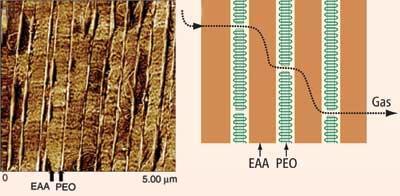Squeezing polymers into nano-layers makes impermeable crystals
Squeezing polymers into extremely thin layers can make them a whole lot less gas-permeable, US scientists have shown. The constrained polymer films are forced to grow as ordered crystallites, forming an effective barrier against diffusing gases.
Anne Hiltner and Eric Baer from Case Western Reserve University in Cleveland, Ohio, were actually trying to develop a selectively permeable polymer when they made their discovery. The team found that sandwiching very thin layers of polyethylene oxide (PEO) between layers of poly(ethylene-co-acrylic acid) (EAA) forces the PEO to form large, crystalline plates that are essentially impermeable to both oxygen and carbon dioxide.
’We were originally trying to modify EAA, which is a typical packaging film resin, with PEO, which has an unusual selectivity for transporting oxygen and carbon dioxide, to try and make a film which could separate the two gases,’ says Hiltner. ’What we came up with was something totally different - an exceptional change in the overall permeability and a whole new structure.’

The team modified a well-established polymer processing technique known as co-extrusion, in which two or more molten polymers are extruded through a special die, to make the films. The crucial modification was to take the extruded molten polymer, divide it in half, and then recombine the two halves, doubling the number of layers in a manner akin to making puff pastry.
This process is then repeated until there are about 1,000 individual layers in a film about 25 microns thick, typical of commonly used packaging films. And the thinner they made the PEO layers, the more crystalline they became - until at 20nm the layers were almost completely made up of large, plate-like crystallites. As the polymers solidify from the molten state, the confined PEO layers are forced to form a more ordered, space-filling crystalline solid, rather than the amorphous solid which would normally form when the melt is cooled.
’I was really surprised to see this unique morphology,’ says Piet Lemstra, professor of polymer technology at Eindhoven University of Technology in the Netherlands. ’To grow single crystals from the melt is normally impossible, they were only really grown out of very dilute solutions before.’
By forming tightly-packed crystals, rather than an amorphous spaghetti-like mass of tangled polymer chains, the PEO layers block diffusion of gas molecules through the film, as they can only pass through at the boundaries between crystals. By having lots of layers, the path a molecule would have to take to diffuse through the film becomes extremely tortuous, making it almost impermeable.
’This is also a continuous process - we can already make miles and miles of these micro- or nano-layered films, so it should be easy to transfer to an industrial scale,’ adds Baer. However, Lemstra is a little less certain: ’The technology for making thin films with multi-layer arrangements is available, but in this case the layers are very, very thin, which is not so easy. The beauty of this work is that it’s already on a reasonably large scale, but whether it can be translated into technology depends on it being picked up by an industrial company.’
These kinds of layered polymers have all sorts of potential applications, Baer told Chemistry World. ’Using different polymers and size scales we can make light filters, we can put dyes in the layers to make all-plastic lasers, and we’re also working on dielectric materials for energy storage.’
Phillip Broadwith
References
H Wang et alScienceDOI: 10.1126/science.1164601






2 readers' comments